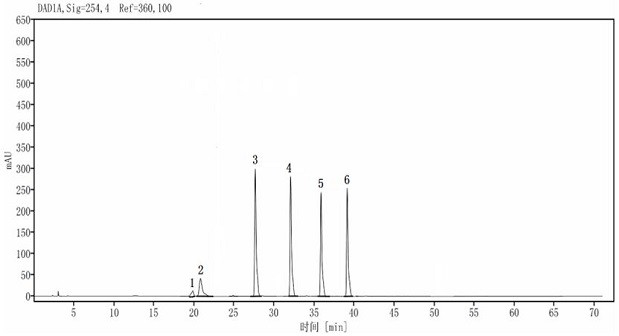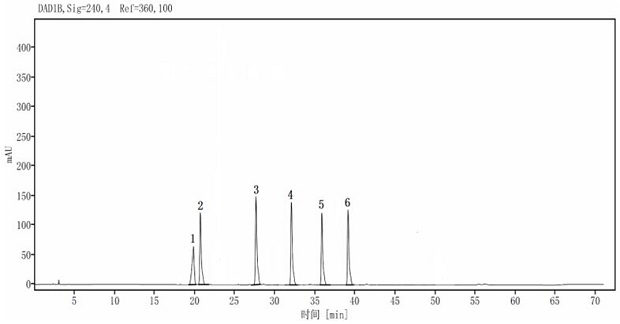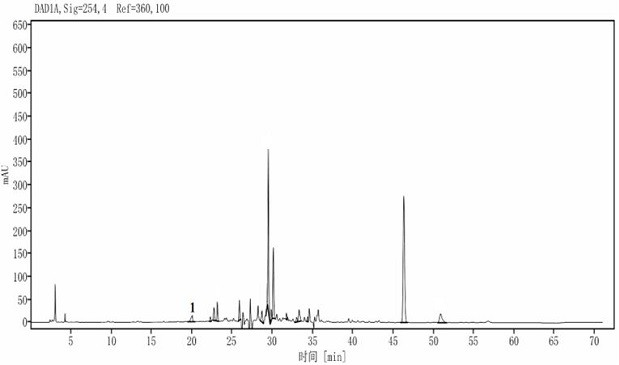A method for screening and quantitative analysis of preservative components in compound licorice tablets
A compound licorice tablet and a determination method are applied in the field of screening and quantitative analysis of preservative components in compound licorice tablets, and can solve the problems that the preservative components cannot be well separated, and the degree of separation cannot meet the analysis requirements.
- Summary
- Abstract
- Description
- Claims
- Application Information
AI Technical Summary
Problems solved by technology
Method used
Image
Examples
Embodiment 1
[0034] 1. Instruments and reagents
[0035] Agilent1260 Ⅱ high performance liquid chromatography (preparation of quaternary pump, online degasser, DAD detector, automatic sampler, Open LAB CDS 2.X chemical workstation), XS205DU electronic analytical balance (Mettler Toledo company), ultrasonic instrument.
[0036] Methanol, acetonitrile, ethanol, and formic acid are chromatographically pure, potassium dihydrogen phosphate is analytically pure, and water is ultrapure water. Reference substances sodium benzoate (100433-201702, 99.7%), potassium sorbate (calculated as sorbic acid, 101075-201602, 99.7%), methylparaben (100278-201705, 100%), ethylparaben (100847- 201604, 99.9%), propylparaben (100444-201804, 99.60%), and butylparaben (190010-201001, 99.70%) were purchased from China National Institute for Food and Drug Control. Compound licorice tablets came from 6 different batches of 3 different manufacturers.
[0037] 2. Analysis method
[0038] 1. Preparation of diluent
[...
Embodiment 2
[0068] Embodiment two: the investigation of different solvents to positive sample extraction effect
[0069] 1. Preparation of positive samples
[0070] According to the prescription ratio of Compound Licorice Tablets, a certain amount of potassium sorbate (calculated as sorbic acid), methylparaben, ethylparaben, propylparaben, and butylparaben was added respectively to prepare a preservative containing the Known positive samples (containing sodium benzoate, potassium sorbate (calculated as sorbic acid), methylparaben, ethylparaben, propylparaben, and butylparaben are 2.02mg / tablet, 0.45mg / tablet, 0.075 mg / tablet, 0.076 mg / tablet, 0.074 mg / tablet, 0.075mg / tablet).
[0071] 2. Other conditions are the same as in Example 1, and the extraction effects of different solvent dilutions on positive samples are investigated respectively, as shown in Tables 4.1-4.4.
[0072] Table 4.1 Extraction effect of methanol
[0073]
[0074] Table 4.2 Extraction effect of ethanol
[0075] ...
Embodiment 3
[0081] Embodiment three: in chromatographic conditions, the selection of detection wavelength
[0082] Other conditions are the same as embodiment one, and reference substance solution is carried out chromatographic analysis, adopts DAD detector, obtains the ultraviolet light absorption spectrum of each compound, and wherein the maximum absorption wavelength of benzoic acid is 224nm, sorbic acid, methylparaben, ethylparaben Esters, propylparaben, and butylparaben all have the maximum absorption at 254nm wavelength. Considering the interference of each component of Compound Licorice Tablets and the detection sensitivity of the analyte, the final selection of methylparaben, ethylparaben, and propylparaben The detection wavelength of ester and butylparaben is 254nm, and the detection wavelength of sodium benzoate and sorbic acid is 240nm.
PUM
 Login to View More
Login to View More Abstract
Description
Claims
Application Information
 Login to View More
Login to View More - R&D
- Intellectual Property
- Life Sciences
- Materials
- Tech Scout
- Unparalleled Data Quality
- Higher Quality Content
- 60% Fewer Hallucinations
Browse by: Latest US Patents, China's latest patents, Technical Efficacy Thesaurus, Application Domain, Technology Topic, Popular Technical Reports.
© 2025 PatSnap. All rights reserved.Legal|Privacy policy|Modern Slavery Act Transparency Statement|Sitemap|About US| Contact US: help@patsnap.com



